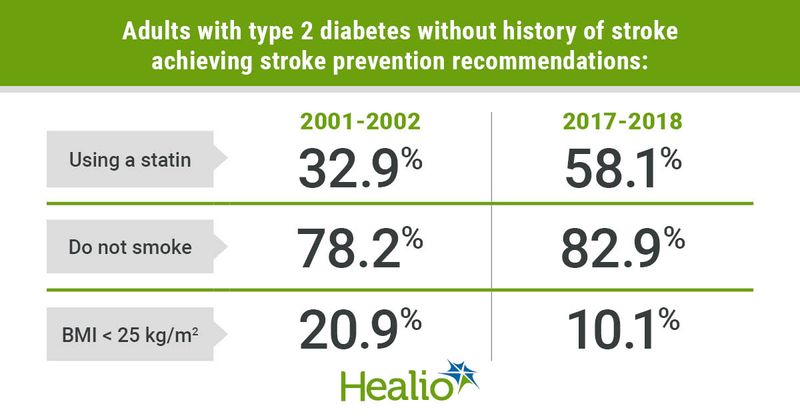Adherence to stroke prevention guidelines improving, but still suboptimal in diabetes
More adults with type 2 diabetes achieved guideline-recommended strategies for stroke prevention in 2018 compared with 2001, but further improvements are needed, according to study findings published in Diabetes Care.
In a cross-sectional analysis of adults with type 2 diabetes aged 45 years and older participating in the National Health and Nutrition Examination Survey from 2001-2002 to 2017-2018, the proportion of participants meeting recommended health behaviors, treatment goals and pharmacotherapies increased over time, though the percentage of those failing to meet goals remains high, according to Stanley Kuo, RPh, PhD, assistant research scientist at the University of Michigan Medical School.

“These findings suggest that the achievement of current guideline-recommended strategies for primary and secondary stroke prevention has some improvement over recent years in the type 2 diabetes population but remains suboptimal,” Kuo told Healio. “Knowing the status and magnitude of achieving each of the current guideline-recommended strategies for stroke prevention can facilitate designing individualized and incentivized interventions to further improve the implementation of these stroke prevention strategies in the type 2 diabetes population at the patient, provider and health policy levels.”

Kuo and colleagues analyzed data from nine NHANES cycles from 2001-2002 to 2017-2018. Adults aged 45 years and older with type 2 diabetes were included in the study. The cohort was stratified by self-reported stroke history. Adherence to stroke prevention was measured by the percentage of participants reaching American Diabetes Association, American Heart Association and American Stroke Association recommendations of an HbA1c between 7% and 8%; a systolic and diastolic blood pressure less than 140 mm Hg/90 mm Hg; a BMI less than 25 kg/m2; use of statin therapy, treatment with aspirin or clopidogrel for those with a 10-year atherosclerotic cardiovascular disease (ASCVD) risk of greater than 10%; no smoking; and treatment with an angiotensin-converting enzyme (ACE) inhibitor or angiotensin receptor blocker in those with hypertension or with hypertension and albuminuria.
There were 4,834 NHANES participants included in the study, of whom 4,300 had no history of stroke and 534 reported a history of stroke. The percentage of those achieving primary stroke prevention strategies ranged from 8.4% for treatment with aspirin and clopidogrel in those with high ASCVD risk to 80.5% for not smoking. The percentage of participants achieving secondary prevention strategies ranged from 11.8% of participants reaching the BMI target to 80% reaching the HbA1c target. Adults with a history of stroke were more likely to reach the HbA1c target (80% vs. 60.2%), use a statin (61.4% vs. 54.3%), and use aspirin or clopidogrel with a high risk of ASCVD (24.8% vs. 8.4%), and were less likely to reach their BP target (63.4% vs. 70.6%) compared with those without a history of stroke.
From 2001-2002 to 2017-2018, the percentage of people with type 2 diabetes taking a statin increased from 32.9% to 58.1% in those with no stroke history (P < .0001) and from 39.4% to 62.1% in people with a history of stroke (P = .01). There was no significant change in the proportion of people at high risk for ASCVD taking aspirin or clopidogrel.
Among those with no stroke history, the percentage of nonsmokers increased from 78.2% to 82.9% (P = .01), the proportion of adults achieving the target BMI decreased from 20.9% to 10.1% (P < .001) and the percentage of people with hypertension using an ACE inhibitor or angiotensin receptor blocker increased from 48.2% to 63.2% (P = .04) from 2001-2002 to 2017-2018. No changes in any of those recommendations were observed for people with a history of stroke.
Kuo said it is crucial for researchers to continue monitoring how well people with type 2 diabetes are adhering to strategies for stroke prevention and which direction trends go in the future.
“Also, health disparity is a critical issue in the U.S., and future research can further investigate the trends in achieving guideline-recommended strategies for stroke prevention among demographic subgroups,” Kuo said.
For more information:
Stanley Kuo, RPh, PhD, can be reached at shihchk@med.umich.edu.
